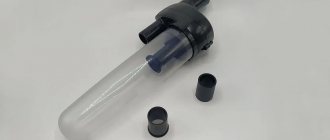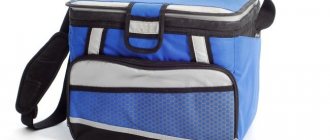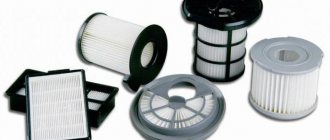When buying a vacuum cleaner for your home, carefully study the technical characteristics and design features, which determine the quality of cleaning and operating conditions. More and more manufacturers are abandoning the dust bag and using a cyclone filter for a vacuum cleaner - a large plastic container in which waste is separated.
What is the operating principle of such a unit, what are its advantages over traditional devices? Let's look at these questions in order, and also give a brief overview of cyclonic vacuum cleaners.
How does a cyclone filter work?
The principle of operation of the cyclone filter is to clean the air coming out of the vacuum cleaner. As the vacuum cleaner sucks in air, debris enters the cyclone filter from the side, thereby creating spiral movements.
Large debris is usually attracted to the walls, and dust swirls around the filter. When the air flow reaches the end of the filter, it reverses its direction and suddenly loses speed. This process allows large debris to fall into the dust bin. Next, the air, cleared of debris, comes out through the exhaust hole of the vacuum cleaner.
Pros and cons of a cyclone
The main advantages of a cyclone filter:
- deep cleaning of the surface due to multi-level filtration;
- minimal dust emissions when air exits the vacuum cleaner;
- convenient cleaning of the filter and dust collector;
- compactness, since the filter usually has small dimensions (one of the reasons for its frequent use on vertical vacuum cleaners);
- the ability to wash all parts of the structure;
- The absence of dust bags saves money.
Also worth noting is the strength of the filter container, which, unlike cloth or paper bags, can hold back glass or nails. Typically, vacuum cleaners with cyclone filters have filling indicators, but if they are absent, clogging can be determined by a decrease in suction power.
With all its advantages, the cyclone filter also has a number of disadvantages:
- rapid reduction in power when clogged;
- increased noise level;
- increased cleaning time due to low power;
- passage of small dust particles.
Since in standard models of vacuum cleaners with cyclone filters, dust microparticles fly out with the exhaust air stream, it is recommended for allergy sufferers to purchase a model with an aquafilter and an increased level of filtration.
Criteria for choosing home appliances
In recent years, the number of people wishing to purchase a vacuum cleaner with a cyclone filter has increased significantly.
Accordingly, the range of such equipment is growing, and the price range is also expanding. In order not to get confused in all this variety of offers, it is useful for consumers to know what characteristics they need to pay attention to when choosing a high-quality and reliable cyclone vacuum cleaner:
- Power. It is this parameter that should be taken into account first of all when choosing a vacuum cleaner with a cyclone filter. It is necessary to look at the consumption and suction power of the selected device. Manufacturers do not always provide information about the last parameter in the description of the model. Therefore, models with a power of 1800 W or more can be a guideline.
- Volume of the dust collection container. Although this parameter does not affect performance in any way, it should also be taken into account. If you decide to purchase a model with a small collector, you will have to take breaks more often to empty it. The disadvantage of devices with large containers is their bulkiness. It is best to choose vacuum cleaners equipped with a medium-sized dust container. This is the best option for most consumers.
- Additional filtration of exhaust air. This feature will make the vacuum cleaner more efficient, although it may increase its cost slightly. Most models are equipped with carbon HEPA filters that can clean the air even from small dust particles. Such a filtration system has become widespread in medical institutions, where the highest demands are placed on air quality.
- Additional equipment. The usual classic model of a cyclone vacuum cleaner comes with a set of 3-6 replaceable nozzles. It should be noted that the efficiency of the cleaning process directly depends on the number of attachments. Some manufacturers often include a replaceable cyclone filter in the kit, which may be an additional reason for the buyer to choose this particular model. After all, then you won’t have to spend money on buying a new part and wait for the filter to dry after washing; it will be enough to install a spare one instead.
- General characteristics of the equipment. For some consumers, the length of the wire and the length of the hose may not be the least important. If they are not long enough, using a vacuum cleaner will be inconvenient. Although in the assortment of all manufacturers you can find models that have the function of adjusting the hose or pipe, you should first find out the maximum length so that it is suitable for the owner’s height. The vacuum cleaner can create certain inconveniences if the cord is too long, it will get tangled and interfere. The reverse function allows you to avoid such inconveniences, thanks to which the cord begins to rewind on its own as the person with the vacuum cleaner approaches the outlet. Although this option will increase the cost of the vacuum cleaner slightly, it will make it more convenient to use.
- Material of pipes and their fastening. Over time, plastic tubing can crack or even break. Metal ones are more reliable, but a lot depends on the operating time of the vacuum cleaner. The mounts should not only be highly durable, but also rotate 360 degrees, following the user’s movements during cleaning.
Types of cyclone filters
Vacuum cleaners are divided into three types: vertical, horizontal and automatic robotic. Each of them differs in maximum power and design. For example, in manual vacuum cleaners, the filters are located on the handle itself and are small in size, which makes them compact and quickly clog.
On standard vacuum cleaners, the cyclones are in a horizontal position and have large volumes, which increases the power and quality of cleaning. Robot vacuum cleaners have too small filters, so the quality of their cleaning is in last place, except for premium equipment with innovative technologies.
Depending on the type of vacuum cleaner, the appearance and design of the filter changes, but the procedure for creating an inertial flow is similar.
Construction [edit | edit code]
There is a huge variety of types of cyclones. In addition to the counter-flow cyclone described above, there are also less common direct-flow cyclones. Counterflow cyclones differ in size, the ratio of the cylindrical and conical parts, as well as the relative height (that is, the ratio of height to diameter) of the cylindrical part. The greater the relative height, the lower the coefficient of hydraulic resistance and the vacuum in the hopper (the less likelihood of dust being sucked into the apparatus), but the lower the degree of cleaning. The optimal relative height is 1.6, which corresponds to the “golden ratio” principle.
Vacuum cleaners with cyclone filter
The difference between a cyclone filter and others is the suction system and the method of processing debris. In appearance, this is an ordinary cylinder with a filter, but the procedure for drawing in and swirling the flow goes through several stages.
Design Features
Under the influence of centrifugal force, debris is separated from the air, which prevents it from penetrating back into the room with the exhaust. The flask, where the swirling process occurs, usually consists of transparent plastic, so you can see not only the blockage, but also the operation of the cyclone.
Principle of operation
Air containing debris is drawn into the side opening of the filter by the vacuum cleaner, thereby creating a centrifuge. With a spiral vortex, debris is separated from the main flow and leans against the walls of the container. Dust microparticles swirl longer and may even remain in the flow. To filter it, another filter in the form of foam rubber or fabric is already installed. Multi-level cleaning requires high power, so when buying a vacuum cleaner, consider this parameter first.
Popular brands of cyclone vacuum cleaners
The most popular brands of vacuum cleaners with different types of designs:
- Dyson. The brand produces mainly vertical cordless vacuum cleaners. The main difference from analogues is the universal and in-depth air purification, which practically does not allow microscopic dust particles to pass through.
- Samsung. The famous brand is popular among fans of horizontal vacuum cleaners. The company regularly develops unique technologies that improve the quality and convenience of home cleaning. Of the latter, we can highlight the Anti-Tangle function, which significantly increases engine speed. Accordingly, the swirl speed also changes and does not allow long debris to wrap around the filter.
- Xiaomi. The Chinese brand is famous for its robotic vacuum cleaners, which come with a wide variety of functions. Despite its small design, the vacuum cleaner has high power. However, the small dust container gets clogged quite quickly.
Tips for use
Caring for the cyclone filter is quite simple - disconnect the structure from the vacuum cleaner and open it. Empty the debris and put the filter back in. Unlike the aqua function, the container does not need to be rinsed with water, however, if necessary, you can wipe it with a wet sponge and soap or detergent. The main condition is to dry the filter before cleaning, since dust residues can accumulate into a single mass and block the free passage of air, which can lead to damage to the device.
How to choose a vacuum cleaner with a cyclone filter
On the market you can find a wide variety of brands with a huge list of functions, but not all of them will be in demand during operation. Choose a vacuum cleaner only from reputable brands, since cheap devices with great functionality may not correspond to reality and quickly fail.
You also need to decide on the type of vacuum cleaner. If cleaning will be done in one or more rooms with small accumulations of garbage, buy a vertical design with a power cord or battery. The cyclone filter in them works quite effectively, and is easy to remove and clean.
For large premises and cleaning companies, it is recommended to choose among horizontal vacuum cleaners, as they have greater power and a capacitive dust collector. In this case, the centrifuge works faster, which allows you to efficiently clean the surface from dust.
Main selection criteria
To figure out how to choose a vacuum cleaner with a cyclone filter, you should decide on the most significant criteria that you need to pay attention to
Suction power
The value of such a parameter as suction power, in most cases, is in the range from 250 to 550 W.
The best cyclone vacuum cleaner for cleaning typically has a suction power of 300-350 watts. In this case, it is possible to avoid unnecessary energy costs without losing the quality of work.
Power consumption
An indicator such as power consumption for cyclone-type vacuum cleaners can be:
- less than 1000 W;
- 1000-1500 W;
- 1600-1900 W;
- 2000 W or more.
When choosing a household appliance based on this parameter, you should be guided by considerations of economy (for example, how appropriate is the power of 3000 W for cleaning a small apartment), as well as by the capabilities of the wiring, since this is an additional load on it.
Advice! As a rule, 1500-2000 W of power consumption is enough for high-quality and complete cleaning of an average room.
Container volume
The container of a cyclone vacuum cleaner can have the following volume:
- less than 1.9 l;
- 2-3.9 l;
- 4-5.9 l.
For information! The most popular models are equipped with dust collectors with a capacity of up to 2 liters. Larger containers are usually equipped with powerful and fairly heavy household appliances, which are unlikely to be suitable for daily cleaning.
Filters
The HEPA filter used in cyclone vacuum cleaners (the abbreviation stands for High Efficiency Particulate Absorption and is translated as highly effective dust retention) is designed for fine purification of the air entering the container, and is one of the components of a multi-level filtration system.
A HEPA filter can be:
- disposable;
- intended for repeated use, when the possibility of washing with water is provided.
Important! After the filter is washed, it must be dried before further use of the household appliance. HEPA filters need to be changed periodically
When choosing a new filter, you should consider that:
HEPA filters need to be changed periodically. When choosing a new filter, you should consider that:
- the amount of debris collected, as well as the durability of the filter, may depend on the area and size of this accessory;
- such a filter is made of very fragile materials placed in a plastic protective shell, its surface consists of evenly distributed folds and is treated with a special chemical composition that removes microorganisms from the air that can pose a danger to allergy sufferers.
There are modifications of such filters from HEPA 10, capable of trapping up to 85% of particles 0.3 microns in size, to HEPA 14, trapping 99% of such particles.
Nozzles
To decide which cyclone vacuum cleaner is better to choose, you should pay attention to whether this household appliance is equipped with different types of attachments. In this case, the kit may include:
In this case, the kit may include:
- a turbo brush, which is usually equipped with carbon fiber bristles, has adjustments that allow you to change the suction force, and is easy to disassemble for cleaning;
- mini-turbo brush, which allows you to clean hard-to-reach places, as well as clean clothes or furniture;
- Turbo mini nozzle, designed for cleaning small debris, hair, animal hair, lint from pillows, dust, etc.;
- a parquet brush that is suitable for caring for smooth surfaces - parquet, laminate, linoleum, etc.
In addition, some brands of this type of vacuum cleaner offer telescopic pipes with types of attachments such as MultiClean, Turbo Brush, Musclehead and others, which may be required for cleaning in any specific conditions.
Vacuum cleaner attachments
Cord length
The power cord can increase or decrease the range of the appliance. To determine which vacuum cleaner with a cyclone filter to choose, you should also consider the length of the power cord.
For most of the most popular brands today, such as Samsung, Dyson, Bosch, LG, Polaris and others, this parameter ranges from 4 to 10 meters.
Suction pipe
The most convenient to use is the telescopic suction pipe. The design of such a pipe allows you to change its length as needed and expand the reach if required.
How to make a cyclone filter yourself: step-by-step guide
In the case of a cyclone filter, you can save money by creating it yourself from scrap materials.
We prepare tools and material
To work you will need:
- plastic pipe with a diameter of 50 mm and a length of up to 150 mm;
- a piece of plywood;
- hose of a standard vacuum cleaner;
- two buckets 5 l and 10 l;
- plumbing angle 30 degrees;
- electric drill with a crown and various drills;
- ruler;
- construction compass;
- pencil;
- jigsaw;
- clamp;
- stationery knife.
We make the case
- Take a knife and cut the sides of a 5 liter bucket.
- Turn the container upside down, place it on a sheet of plywood and draw a circle around it with a pencil.
- Using a construction compass, mark 30 mm to the periphery, draw another circle and cut with a jigsaw.
- Make a shape for the ring. To do this, draw another circle using a bucket: roughly mark the bottom point and use a compass to make diagonal marks of approximately 100 mm in both directions.
- Take a crown with a diameter of 50 mm and make holes at the marked points, but only so that they do not extend beyond the marked ring.
- Measure 50 mm from the main ring and draw a circle, the points of which will touch the cut holes.
We connect the blanks
Place the cut ring onto a 5 liter bucket in the upper part where the sides were cut off and secure it with self-tapping screws from the inside. It is important to seal all cracks and holes between parts, so use more fasteners around the circumference. Cut the lid of a 10 liter bucket exactly in the center and secure it to the cylinder with self-tapping screws.
Installing the inlet pipe
The pipe must be secured on the opposite side of the cylinder hole. To do this, step back 10 mm from the bottom and use a 50 mm crown to make an inlet hole. To further seal the plumbing corner, make the cut hole in the form of a drop. Then use sealant and a self-tapping screw to secure the corner.
The second pipe is installed in a similar way. A plastic pipe 50 mm in diameter and 100–130 mm in length must be inserted in the center of the bottom of the cylinder. You can cut a small square out of plywood and make a 50 mm hole using a hole saw, then insert a pipe into it and secure it with sealant.
Mounting a figured element
The main point of the procedure is the installation of a figured element made of plywood, since it is this element that will create the turbulence in the cylinder. Fasten the plate 10 mm from the edge of the open part of the cylinder, while the shaped element should not come into contact with the pipe. From the outside, secure the tightly fitting part of the plate using a self-tapping screw, it is important that it is positioned strictly horizontally.
Final assembly
The final stage of assembly involves connecting ready-made parts, namely the cylinder itself and a large bucket. The previously installed lid of a large bucket will help to fit tightly. The total height of the structure will be 45–60 cm.
How to connect a homemade cyclone
Insert a corrugated hose from any working tool into the inlet hole, and insert a tube from a vacuum cleaner into the outlet hole, instead of the working nozzle. Before work, start the vacuum cleaner, and then the tool. Chips or debris will pass through the corrugated pipe directly into the homemade cyclone filter. Debris will be sifted out in the cylinder and clean air will come out through the exhaust of the vacuum cleaner.
Where is an industrial vacuum cleaner with a cyclone filter useful?
An industrial vacuum cleaner has an appearance similar to a homemade one made from buckets. It also consists of two cylinders, one with a cyclone filter, the other for collecting dust. Typically, such equipment is made of metal, and the engine has increased power for a long service life. An industrial vacuum cleaner can be used not only at a construction site or enterprise, but also at home. It is not advisable to use it in an apartment, but during renovations or in the garage it is a very useful thing.
Positive aspects of cyclones
Cyclone-type vacuum cleaners owe their popularity precisely to the dust accumulation device. It is designed to prevent dirt from leaving the tank once it gets there.
Advantages of models with a cyclone filter:
- increased operating time thanks to a multi-stage filtration system;
- compactness of the dust container;
- ease of maintenance - dust removal occurs quite quickly;
- hygiene – contact with dirt is reduced to a minimum;
- the ability to wash and clean all parts of the dust collector;
- economical, no need to spend money on consumables - bags.
The durable plastic from which containers are usually made is commendable. It does not break from mechanical impact when hard or sharp objects get inside, and the bag can easily tear if a nail or glass accidentally ends up in it.
The compartments of the tank are located in such a way that they trap large objects and prevent them from mixing with dust. Thanks to this, you can find a lost ring or a necessary part that was accidentally dropped on the floor
If there is no special full indication, you can judge the amount of debris in the dust collector by the drop in power. As soon as it weakens, it’s time to remove the dust.
Where to buy a cyclone filter for a vacuum cleaner
Vacuum cleaners with a cyclonic cleaning system are among the most popular, so they can be purchased at almost every household appliance store. If you need a filter for an industrial vacuum cleaner, then it can only be purchased in specialized stores. When choosing a filter, pay attention to the identity of the product with the original, since filters may have different shapes and connection points.
The main criteria for choosing a vacuum cleaner with a cyclone filter are power, compactness and ease of use. When purchasing, also take into account the popularity and integrity of the manufacturer of cleaning equipment. If you need to clean a large room, or after renovation or construction, buy or make your own cyclone filter for an industrial vacuum cleaner.
Advantages
Unlike conventional vacuum cleaners equipped with bags for collecting dust and debris, cyclones have a number of undeniable advantages.
- Cyclone models have small dimensions compared to classic vacuum cleaners, so there are never any problems with where to put the device until the next use. In addition, it is much easier to manipulate during cleaning.
- The cyclone type vacuum cleaner is a universal model. That is, it is intended not only for dry cleaning (garbage, wool or dust), but also for cleaning surfaces of various types (sofas, armchairs, natural coverings, tiles, wooden surfaces and much more). Moreover, in the process of using a vacuum cleaner, all risks regarding the likelihood of damage to the surface of the things being cleaned are reduced to zero.
- These models demonstrate consistently high power levels during operation. Simply put, cyclone filters are equipped in such a way that even despite the complete filling of the dust collector (garbage container), the dirt and dust collection power continues to remain at the original level. So, the debris inside the container in no way affects the performance of the cyclone vacuum cleaner.
- Reasonable price for equipment. Due to the fact that cyclone filters have a low cost, vacuum cleaner models equipped with them have a competitive price. Thus, any average family can afford a universal gadget.
- These models are easy to maintain and use. There are no complex technical structures or electronic components in the device, so even a child can understand the operation of the vacuum cleaner. Cleaning the container also does not require special skills - it does not need to be washed, cleaned for a long time or periodically changed, like dust bags.
- These filters have an increased level of noise insulation, unlike conventional vacuum cleaner models. Moreover, cyclone vacuum cleaners never operate to the point of overload, causing a strong noise effect.
- Thanks to cyclone filters, it is very easy to find small lost parts that accidentally fell into the vacuum cleaner during cleaning. The device is equipped in such a way that the parts settle directly on the surface of the filter, and do not penetrate inside the dust collector along with the rest of the dirt and dust.
- These models, unlike analog vacuum cleaners, have longer service life if used correctly.
- Saving on the purchase and replacement of waste collection bags. After all, containers for dirt do not need to be constantly purchased and replaced with new ones. The filter, made of plastic, is quite durable and reliable, so it is not afraid of mechanical damage.
- Modern models of such vacuum cleaners are equipped with many additional convenient functions that are indispensable in the process of cleaning and housekeeping.
- The models have a unique modern design that fits well into the interior of any home.
- The developers have provided portable models that operate not from the mains, but from a battery. This device is ideal for cleaning cars and other compact surfaces.
Such filters are always available for free sale. Therefore, in case of failure, you can purchase them at any specialized household appliance store at an affordable price.











